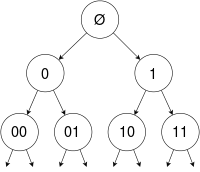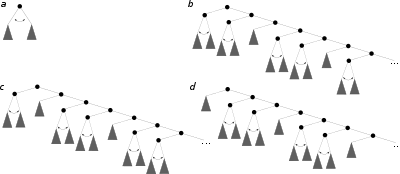Grigorchuk group
In the mathematical area of group theory, the Grigorchuk group or the first Grigorchuk group is a finitely generated group constructed by Rostislav Grigorchuk that provided the first example of a finitely generated group of intermediate (that is, faster than polynomial but slower than exponential) growth. The group was originally constructed by Grigorchuk in a 1980 paper[1] and he then proved in a 1984 paper[2] that this group has intermediate growth, thus providing an answer to an important open problem posed by John Milnor in 1968. The Grigorchuk group remains a key object of study in geometric group theory, particularly in the study of the so-called branch groups and automata groups, and it has important connections with the theory of iterated monodromy groups.[3]
History and significance
The growth of a finitely generated group measures the asymptotics, as of the size of an n-ball in the Cayley graph of the group (that is, the number of elements of G that can be expressed as words of length at most n in the generating set of G). The study of growth rates of finitely generated groups goes back to the 1950s and is motivated in part by the notion of volume entropy (that is, the growth rate of the volume of balls) in the universal covering space of a compact Riemannian manifold in differential geometry. It is obvious that the growth rate of a finitely generated group is at most exponential and it was also understood early on that finitely generated nilpotent groups have polynomial growth. In 1968 John Milnor posed a question[4] about the existence of a finitely generated group of intermediate growth, that is, faster than any polynomial function and slower than any exponential function. An important result in the subject is Gromov's theorem on groups of polynomial growth, obtained by Gromov in 1981, which shows that a finitely generated group has polynomial growth if and only if this group has a nilpotent subgroup of finite index. Prior to Grigorchuk's work, there were many results establishing growth dichotomy (that is, that the growth is always either polynomial or exponential) for various classes of finitely generated groups, such as linear groups, solvable groups,[5][6] etc.
Grigorchuk's group G was constructed in a 1980 paper of Rostislav Grigorchuk,[1] where he proved that this group is infinite, periodic and residually finite. In a subsequent 1984 paper[2] Grigorchuk proved that this group has intermediate growth (this result was announced by Grigorchuk in 1983).[7] More precisely, he proved that G has growth b(n) that is faster than but slower than where . The upper bound was later improved by Laurent Bartholdi[8] to
A lower bound of was proved by Yurii Leonov.[9] The precise asymptotics of the growth of G is still unknown. It is conjectured that the limit
exists but even this remains a major open problem.
Grigorchuk's group was also the first example of a group that is amenable but not elementary amenable, thus answering a problem posed by Mahlon Day in 1957.[10]
Originally, Grigorchuk's group G was constructed as a group of Lebesgue-measure-preserving transformations on the unit interval, but subsequently simpler descriptions of G were found and it is now usually presented as a group of automorphisms of the infinite regular binary rooted tree. The study of Grigorchuk's group informed in large part the development of the theory of branch groups, automata groups and self-similar groups in the 1990s–2000s and Grigorchuk's group remains a central object in this theory. Recently important connections between this theory and complex dynamics, particularly the notion of iterated monodromy groups, have been uncovered in the work of Volodymyr Nekrashevych.[11] and others.
After Grigorchuk's 1984 paper, there were many subsequent extensions and generalizations.[12][13][14][15]
Definition

Although initially the Grigorchuk group was defined as a group of Lebesgue measure-preserving transformations of the unit interval, at present this group is usually given by its realization as a group of automorphisms of the infinite regular binary rooted tree T2. The tree T2 is realized as the set of all finite strings in the alphabet plus the empty string which is the root vertex of T2. For a vertex x of T2 the string x0 is the left child of x and the string x1 is the right child of x in T2. The group of all automorphisms Aut(T2) can thus be thought of as the group of all length-preserving permutations σ of that also respect the initial segment relation, that is such that whenever a string x is an initial segment of a string y then σ(x) is an initial segment of σ(y).
The Grigorchuk group G is then defined as the subgroup of Aut(T2) generated by four specific elements of Aut(T2):
where the automorphisms a, b, c, d are defined as follows (note that is fixed by all automorphisms of the tree):

We see that only the element a is defined explicitly and the elements b, c, d are defined recursively. To get a better picture of this action we note that has a natural gradation into levels given by the length of the strings:
Now let denote the union of all vertices with level This means:
Since automorphisms of the tree are length-preserving, as a set is fixed by for all With this in mind we write:
We call (resp. ) the left (resp. right) branch and denote it by (resp. ). With this notation we see that:
Now we can also write the action of the elements b, c and d in terms of the disjoint union as follows:
Similarly we have:
Properties
The following are basic algebraic properties of the Grigorchuk group (see[16] for proofs):
- The group G is infinite.[2]
- The group G is residually finite.[2] Let be the restriction homomorphism that sends every element of G to its restriction to the finite tree T[n]. The groups Aut(T[n]) are finite and for every nontrivial g in G there exists n such that
- The group G is generated by a and any two of the three elements b,c,d. For example, we can write
- The elements a, b, c, d are involutions.
- The elements b, c, d pairwise commute and bc = cb = d, bd = db = c, dc = cd = b, so that is an abelian group of order 4 isomorphic to the direct product of two cyclic groups of order 2.
- Combining the previous two properties we see that every element of G can be written as a (positive) word in a, b, c, d such that this word does not contain any subwords of the form aa, bb, cc, dd, cd, dc, bc, cb, bd, db. Such words are called reduced.
- The group G is a 2-group, that is, every element in G has finite order that is a power of 2.[1]
- The group G has intermediate growth.[2]
- The group G is amenable but not elementary amenable.[2]
- The group G is just infinite, that is G is infinite but every proper quotient group of G is finite.
- The group G has the congruence subgroup property: a subgroup H has finite index in G if and only if there is a positive integer n such that
- The group G has solvable subgroup membership problem, that is, there is an algorithm that, given arbitrary words w, u1, ..., un decides whether or not w represents an element of the subgroup generated by u1, ..., un.[17]
- The group G is subgroup separable, that is, every finitely generated subgroup is closed in the pro-finite topology on G.[17]
- Every maximal subgroup of G has finite index in G.[18]
- The group G is finitely generated but not finitely presentable.[2][19]
- The stabilizer of the level one vertices in in G (the subgroup of elements that act as identity on the strings 0 and 1), is generated by the following elements:
- is a normal subgroup of index 2 in G and
- A reduced word represents an element of if and only if this word involves an even number of occurrences of a.
- If w is a reduced word in G with a positive even number of occurrences of a, then there exist words u, v (not necessarily reduced) such that:
- This is sometimes called the contraction property. It plays a key role in many proofs regarding G since it allows to use inductive arguments on the length of a word.
- The group G has solvable word problem and solvable conjugacy problem (consequence of the contraction property).
See also
References
- R. I. Grigorchuk. On Burnside's problem on periodic groups. (Russian) Funktsionalyi Analiz i ego Prilozheniya, vol. 14 (1980), no. 1, pp. 53–54.
- R. I. Grigorchuk, Degrees of growth of finitely generated groups and the theory of invariant means. Izvestiya Akademii Nauk SSSR. Seriya Matematicheskaya. vol. 48 (1984), no. 5, pp. 939–985.
- Volodymyr Nekrashevych. Self-similar groups. Mathematical Surveys and Monographs, 117. American Mathematical Society, Providence, RI, 2005. ISBN 0-8218-3831-8.
- John Milnor, Problem No. 5603, American Mathematical Monthly, vol. 75 (1968), pp. 685–686.
- John Milnor. Growth of finitely generated solvable groups. Archived 2011-05-23 at the Wayback Machine Journal of Differential Geometry. vol. 2 (1968), pp. 447–449.
- Joseph Rosenblatt. Invariant Measures and Growth Conditions, Transactions of the American Mathematical Society, vol. 193 (1974), pp. 33–53.
- Grigorchuk, R. I. (1983). К проблеме Милнора о групповом росте [On the Milnor problem of group growth]. Doklady Akademii Nauk SSSR (in Russian). 271 (1): 30–33.
- Laurent Bartholdi. Lower bounds on the growth of a group acting on the binary rooted tree. International Journal of Algebra and Computation, vol. 11 (2001), no. 1, pp. 73–88.
- Yu. G. Leonov, On a lower bound for the growth of a 3-generator 2-group. Matematicheskii Sbornik, vol. 192 (2001), no. 11, pp. 77–92; translation in: Sbornik Mathematics. vol. 192 (2001), no. 11–12, pp. 1661–1676.
- Mahlon M. Day. Amenable semigroups. Illinois Journal of Mathematics, vol. 1 (1957), pp. 509–544.
- Volodymyr Nekrashevych, Self-similar groups. Mathematical Surveys and Monographs, 117. American Mathematical Society, Providence, RI, 2005. ISBN 0-8218-3831-8.
- Roman Muchnik, and Igor Pak. On growth of Grigorchuk groups. International Journal of Algebra and Computation, vol. 11 (2001), no. 1, pp. 1–17.
- Laurent Bartholdi. The growth of Grigorchuk's torsion group. International Mathematics Research Notices, 1998, no. 20, pp. 1049–1054.
- Anna Erschler. Critical constants for recurrence of random walks on G-spaces. Archived 2011-07-25 at the Wayback Machine Université de Grenoble. Annales de l'Institut Fourier, vol. 55 (2005), no. 2, pp. 493–509.
- Jeremie Brieussel, Growth of certain groups Archived 2011-10-02 at the Wayback Machine, Doctoral Dissertation, University of Paris, 2008.
- Pierre de la Harpe. Topics in geometric group theory. Chicago Lectures in Mathematics. University of Chicago Press, Chicago. ISBN 0-226-31719-6; Ch. VIII, The first Grigorchuk group, pp. 211–264.
- R. I.Grigorchuk, and J. S. Wilson. A structural property concerning abstract commensurability of subgroups. Journal of the London Mathematical Society (2), vol. 68 (2003), no. 3, pp. 671–682.
- E. L. Pervova, Everywhere dense subgroups of a group of tree automorphisms. (in Russian). Trudy Matematicheskogo Instituta Imeni V. A. Steklova. vol. 231 (2000), Din. Sist., Avtom. i Beskon. Gruppy, pp. 356–367; translation in: Proceedings of the Steklov Institute of Mathematics, vol 231 (2000), no. 4, pp. 339–350.
- I. G. Lysënok, A set of defining relations for the Grigorchuk group. Matematicheskie Zametki, vol. 38 (1985), no. 4, pp. 503–516.